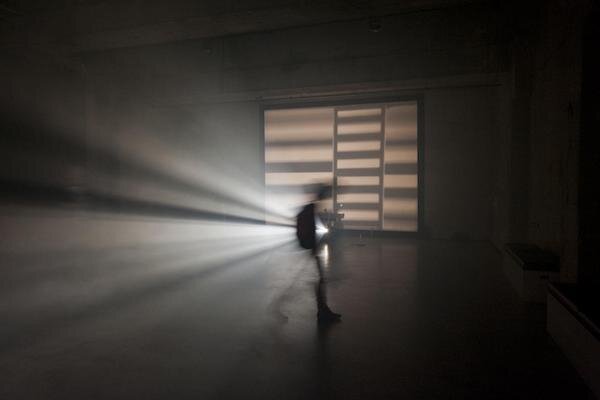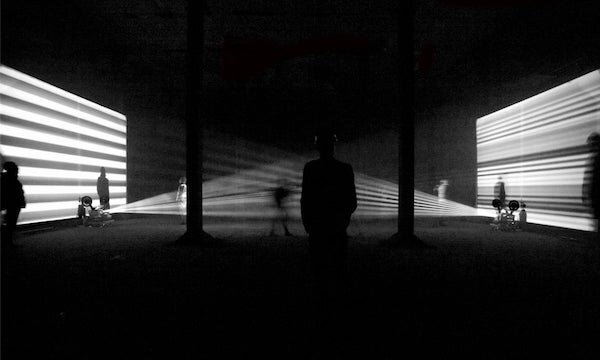Filmmaker and artist, Lis Rhodes questioned the very nature and format of performance throughout her vibrant and daring career. Rhodes advocated for a new kind of history, a bolder performance of our cultural reality. Exploring her immersive work and the ties that bind her to John Berger and Margaret Thatcher, Belphoebe New reminds us why there is still nobody else doing it like Rhodes.
In 1979, the British artist and filmmaker Lis Rhodes was asked to participate in the exhibition ‘Film as Film’, a survey of experimental cinema at the Hayward Gallery, London. She was the only woman to be invited to feature her work. In response, Rhodes collaborated with other artists, including Annabel Nicholson, Felicity Sparrow and Susanne Stein, to research the history of women filmmakers. This alliance led Rhodes to withdraw from the exhibition, choosing instead to write a series of essays in the exhibition’s catalogue. One of these essays was Whose History? Rhodes’ manifesto for ‘a different presentation of history; made by women, about women.’ From this, Rhodes co-founded Circles, the UK’s first women artists’ distribution organisation in the UK.
It was in 2012, on a university study trip, that I first encountered Rhodes’ work Light Music at the Tate Modern. In the cavernous space of the Tanks, two screens and projectors stand on opposite sides, sending bouts of flickering light that meet in the middle of the room. Black and white lines, printed on to the filmstrip, climb down the two screens and are processed through the projector and read as audio, creating a rapid, thunderous soundtrack, the aural and visual dancing together in a perpetual symphony. The viewer can choose to watch from the side or walk (cautiously in my case, as if I was breaking some unspoken boundary) between the projectors, directly into the light, shadow movements forming a part of the performance. It’s an entrancing experience, standing in a hazy room where the line between spectacle and immersion is blurred, the clack and whirr of the projector theatrical yet meditative, the dark patterns puzzling and hypnotising.
In Light Music, image and sound do not merely coexist, they are intrinsic to one another. The springboard for the work was Rhodes’ concern with the lack of representation for women composers in European classical music. Wary of the potential of manipulation when sound is edited over the image, she sought to create a visual language where what we see and what we hear are interchangeable. By fusing the relationship between the audience and the piece, the image and the sound, Rhodes creates transparency; an antithesis to films as historical and cultural documents, where the format can be exploited for the maker’s own means. She asks us to be suspicious and critical of the relationship between form and content. As she explains in Whose History?: ‘The view through the lense may be blurred or defined – focussed or unfocussed – depending on what you think you know; what you imagine you see; what you learn to look for, what you are told is visible.’
In his seminal work Ways of Seeing, John Berger wrote, ‘The way we see things is affected by what we know or what we believe.’ Berger did not typically deal with the moving image, but his view of the relationship between seeing and knowing as a political act relates to Rhodes’ own distrust of film in presenting accurate, unbiased narratives. At the heart of Rhodes’ work is an exploration of the politics of power dynamics: from the dangers of statelessness and exploitation of migrant work in Ambiguous Journeys (2018), to the violence inflicted on women’s bodies and minds by the state in A Cold Draft (1988), and the gendered oppression in the structure of language itself, as explored in Light Reading (1978).
Light Reading depicts a crime scene, with disparate letters chaotically flashing across the screen, occasionally spliced with the nightmarish image of a blood-stained bed. The existential crime committed is something Rhodes described in an interview with the ICA as a question of “whose voice is heard, whose image is used by whom, and whose meanings are meant.” Rhodes’ narrator, speaking in third person of a ‘she’, looks to solve it:
She watched herself being looked at, she looked at herself being watched, but she could not perceive herself as the subject of the sentence.
This narration is starkly similar to Berger’s description of objectivity:
Women watch themselves being looked at. This determines not only most relations between men and women but also the relation of women to themselves. The surveyor of woman in herself is male: the surveyed female. Thus she turns herself into an object - and most particularly an object of vision: a sight.
Rhodes’ narrator struggles to situate herself within a pre-understood language structure, asking open-ended questions that play on language and syntax, further entrenching the mystery: “But which moment of beginning follows which moment of end?” as well as wordplay, “How could she know the which from the witch, or the which from the why?” Speaking about the work in 2015, Rhodes said: “When writing the script, connections became apparent between language and violence, within English grammar a sentence is used to enforce a dualistic opposition between subject and object – what do the abstract structures of grammar tell us about actual society?”Just as Berger’s reading of visual art sees women constrained in a perpetuating loop of watching themselves as an object of the patriarchal gaze, Rhodes’ view of language as informed by power structures situates the woman, striving to see herself as the subject of her own history, even of her own sentence, as the object of a patriarchal one.
Rhodes further utilises her disembodied voiceover in A Cold Draft (1988), which was made during Margaret Thatcher’s period as prime minister and focuses on the oppression of a woman through the lens of state surveillance. Rhodes narrates the experience of a woman considered mad by a sinister authoritarian force, speaking bluntly over images of darkened patterns resembling bones and arteries morphing into bleak city landscapes. She describes completing arduous domestic tasks and manual work (“Her shoulders ached with bending and lifting...she peeled potatoes slowly, to be skinned alive invisibly”) all whilst the ruling body regulates her life and benefits from her labour:
“It had been known, the sentence had been imposed, having been planned, annotated and constructed. We had been executed…the invisible earnings of hypocrisy turned resistance into acceptance.”
Here, Rhodes’ Narrator is gaslit into a position of subjugation, highlighting the tension between her resistance to capitalism and the seemingly impenetrable forces controlling her. Her words establish a cold finality indicating the violence of language: “The sentence had been imposed...we had been executed.” Inspiring images of culturally codified stereotypes such as the hysterical woman, or the lone old woman believed to be a witch, A Cold Draft indicates the gradual and meticulous erosion of the narrator’s sanity to benefit “the invisible earnings of hypocrisy”. For Rhodes, the mechanisms of oppression in patriarchy and capitalism cannot be differentiated.
What unites Rhodes’ body of work is a rejection of the idea that history is neutral: that it is in fact framed within the confines of a patriarchal, neoliberal viewpoint. Her work asks what would happen if we tore up what we already knew from the past, and prioritised difference, rather than working within our current historical context. In Whose History? she explains: ‘I prefer a crumpled heap, history at my feet, not stretched above my head.’ By tying together the fragments of a crumpled heap of history, Rhodes asks us to privilege what we see, to look carefully and critique the objective reality, over what we think we know.
Seven years after first seeing Light Music, I made a pilgrimage to Nottingham to see Rhodes’ solo show Dissident Lines at Nottingham Contemporary. I saw the work again, this time in an empty room, the symphony played just for me. Curious about exploring the rest of her career, I was struck by how she covers so many of the issues surrounding neoliberal politics in the 21st century. Works such as In The Kettle (2012) combine images of London protests with the 2009 bombing of the Gaza Strip, while Journal of Disbelief (2000-2016) presents a damning account of corruption and exploitation in the justice system. Her intersectional approach, untangling the structures of power, language and violence, offers a framework to understand how the oppression of women infiltrates all parts of society. Rhodes refuses to take anything known, accepted, understood at face value. And as she said in A Cold Draft: “It is dangerous to step out of line, yet lethal not to.”
Belphoebe New is an arts writer. Her work has appeared in Dazed, Artsy and in Art Quarterly Magazine. She is based in London and can be found tweeting @ragsoflove.



